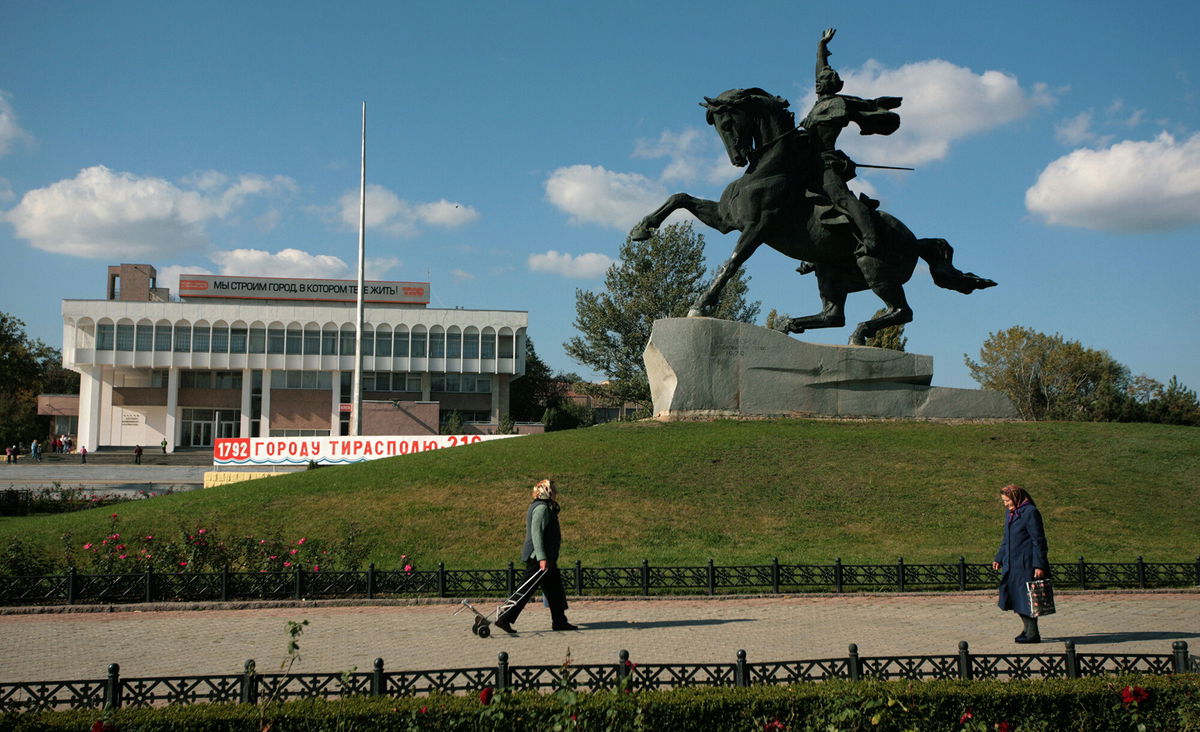How Transnistria, a Russian-backed region in Moldova, is getting pulled into the war in Ukraine

Pictured is the statue of Alexander Suvorov
By Rob Picheta, CNN
A series of unexplained explosions have occurred in parts of Transnistria, a breakaway territory within Moldova that has housed Russian troops for decades, sparking fears that Moscow’s war could soon stretch beyond Ukraine and create a new theater of conflict in eastern Europe.
Two radio towers in the territory were damaged by explosions in the early hours of Tuesday morning, the Transnistrian Ministry of Internal Affairs said in a statement. On Monday, a series of explosions had been heard in Transnistria’s capital Tiraspol, near the Ministry of State Security building, according to Russian state news agency RIA-Novosti.
Ukraine described the blasts as a planned provocation by Russian security services. Ukraine has also blamed Russia for firing cruise missiles Tuesday at a bridge across the estuary of the Dniester River, suggesting Moscow is attempting to cut off the southwestern corner of Ukraine that borders Moldova.
The explosions, and a drip feed of comments by Russian officials regarding the region — including a senior Russian commander saying that the army’s plan to capture southern Ukraine would open up a land corridor stretching to Transnistria — have raised intense concern in Moldova that the disputed territory within its borders is included in Russian President Vladimir’s war strategy.
Transnistria is unrecognized by the international community, which considers it a part of Moldova. But the Moldovan capital, Chisinau, essentially has no control over the territory, which declared itself a republic more than three decades ago.
Here’s what you need to know about the territory.
A disputed land
The collapse of the Soviet Union in 1991 resulted in the emergence of a handful of “frozen conflict” zones in eastern Europe — often-unstable regions where allegiances have been fiercely disputed since the creation of the 15 post-Soviet states.
Those regions include the breakaway statelets of South Ossetia and Abkhazia, inside the territory of Georgia, and the slither of land along Moldova’s border with Ukraine known as Transnistria.
The territory — a 1,300 square mile enclave on the eastern bank of the Dniester River — was the site of a Russian military outpost during the last years of the Cold War. It declared itself a Soviet republic in 1990, opposing any attempt by Moldova to become an independent state or to merge with Romania.
When Moldova became independent the following year, Russia quickly inserted itself as a so-called “peacekeeping force” in Transnistria, sending troops in to back pro-Moscow separatists there.
War with Moldovan forces ensued; the conflict ended in deadlock in 1992. Transnistria was not recognized internationally, even by Russia, but Moldovan forces left it a de facto breakaway state. That deadlock has left the territory and its estimated 500,000 inhabitants trapped in limbo.
Since then, Transnistria has played host to thousands of Russian troops — currently estimated at 1,500 — and developed a reputation as a land lost to time, a Soviet wormhole within a young, transitional Moldovan democracy.
It has a flag, a constitution and a national bank, and celebrates its own independence day.
The major roads of its capital Tiraspol include Lenin Street, Strada Karl Marx and 25th October Street — commemorating the Bolshevik Revolution of 1917. A towering statue of Vladimir Lenin stands in the middle of the city’s main square.
Transnistria has long been powered by its industrial output, and its economy is heavily dependent on Russian subsidies. A conglomerate called Sheriff is almost omnipresent, owning many of its factories, supermarkets and gas stations and lending its name to the region’s soccer club, FC Sheriff, which competes in Moldova’s national league and last year claimed a famous Champions League victory over Real Madrid.
Ethnic Moldovans, Russians and Ukrainains all live in the region. It runs its own presidential and regional elections, though international watchdogs say opposition is suppressed and there is a lack of genuine competition at the ballot box.
The US non-governmental organization Freedom House, which tracks trends in world governments, rates the territory as “not free.”
“Impartiality and pluralism of opinion in the media is very limited, and authorities closely control civil society activity,” it said in its most recent global report.
Despite occasional negotiations with Moldova, the prospect of a resolution to the Transnistria question has remained dim.
“The break-away region persists as a challenge to a unified and developed Moldova,” the United States Agency for International Development (USAID) wrote in 2020.
“There is the risk that those without commercial, family, or personal ties on the other side of the river will increasingly feel estranged from their fellow Moldovans, fostering the kind of mistrust and misunderstanding that can further hinder the resolution of this conflict,” the agency said.
What are Russia’s plans for Transnistria?
Concerns about Russia’s long term plans for Transnistria have never faded — they only intensified after Moscow’s invasion of Crimea in 2014.
That invasion piqued longstanding concerns that Putin would seek to invade and control southern Ukraine. A Russian-backed separatist enclave at the southwestern edge of Ukraine could now present a potential bookend to any Russian assault westwards from Ukraine’s eastern Donbas region.
Russia’s supposed “peacekeeping” presence in Transnistria, which has in practice seen the Kremlin prop up a puppet state that seeks to undermine Moldova’s sovereignty, has also mirrored Moscow’s pretext for invasions in Georgia and Ukraine.
Alarm bells in Moldova and the West grew louder following familiar refrains from the Kremlin that the rights of ethnic Russians were being violated in Transnistria — another argument used by Putin to justify his February invasion of Luhansk and Donetsk in eastern Ukraine, which contained two breakaway Russian-backed statelets.
“Allegedly there, in Moldova, the rights of Russian-speakers are violated,” Ukrainian President Volodymyr Zelensky said in an address last Friday. “Although, to be honest, the territory in which Russia should take care of the rights of Russian-speakers is Russia itself: Where there is no freedom of speech, no freedom of choice. Where there is simply no right to dissent. Where poverty thrives and where human life is worthless.”
After Russia invaded Ukraine, Western nations immediately watched activity in regions beyond the country, including Transnistria.
Some Ukrainian officials also suggested that Russia would at some point draw on its contingent of troops stationed in Transnistria, especially after Moscow suffered a significant number of losses of troops and equipment in the first weeks of its assault on the country.
“Of course, at some point sooner or later they will use them,” the mayor of Odesa Hennadii Trukhanov said in televised remarks this month. “It’s difficult to say in which direction, but there’s a threat. (Armed Forces of Ukraine) know this and are working on this.”
But the most direct and unambiguous statement on the region to date came from Russia’s Central Military District Maj. Gen. Rustam Minnekaev on Friday.
Russian state news agency TASS quoted the general as saying the country’s aim was to create a land corridor between Ukraine’s eastern Donbas region and Crimea, adding that control over Ukraine’s south would give Russian forces access to Transnistria — a strategy that many in Chisinau had long feared was Putin’s goal.
But the most direct and unambiguous statement on the region to date came from Russia’s Central Military District Maj. Gen. Rustam Minnekaev on Friday.
Russian state news agency TASS quoted the general as saying the country’s aim was to create a land corridor between Ukraine’s eastern Donbas region and Crimea, adding that control over Ukraine’s south would give Russian forces access to Transnistria — a strategy that many in Chisinau had long feared was Putin’s goal.
Moldova and Ukraine on alert
Two days after Minnekaev’s comments, a series of explosions were heard in the region.
A correspondent for Russian state news agency RIA-Novosti said powerful booms were heard in Tiraspol and that windows in neighboring houses were damaged.
Immediately, Ukrainian officials suggested the explosions were part of Kremlin efforts to create a narrative that could precede Russian military action.
The Ukrainian Defense Ministry said in a statement that three days before the incident, leaders of the breakaway region “were already preparing for it and took care to install a secure and comfortable bunker” at the Ministry of State Security, which was damaged in the explosions.
“Obviously, this case is one of a number of provocative measures organized by the FSB (the Russian security service) to instil panic and anti-Ukrainian sentiment,” it said.
Two radio towers were subsequently damaged on Tuesday morning. The site where the explosions occurred is known as the “Transnistrian radio and television center,” which was built in the 1960s and is one of 14 Soviet-era radio transmitting centers, according to the Transnistrian Ministry of Internal Affairs.
Ukraine also blamed Russia for firing cruise missiles Tuesday at a bridge across the estuary of the Dniester River. The road and rail bridge links Odesa with the far southwest corner of Ukraine bordering Moldova; the damage essentially cuts the region off.
Maksym Marchenko, head of the Odesa region military administration, said Russia had used three missiles, one of which had struck the bridge. “By his actions, the enemy is trying to cut off part of the Odesa region and create tension amid the events” in Transnistria, Marchenko said. Another attack on the bridge did further damage on Wednesday.
Moldova’s President Maia Sandu on Tuesday condemned the attacks within Transnistria, calling them “provocations” aimed drawing the country into “actions that can endanger peace.”
“Our analysis shows that there are tensions between forces inside that region interested in destabilizing the situation. This makes Transnistria vulnerable and creates risks for the republic of Moldova,” she said at a press briefing following an emergency meeting of the country’s Security Council.
Sandu listed a number of events that proceeded this week’s explosions, including several bomb alerts at schools and medical facilities. She blamed “pro-war factions” attempting to “heighten tensions” in the region.
The-CNN-Wire
™ & © 2022 Cable News Network, Inc., a WarnerMedia Company. All rights reserved.



